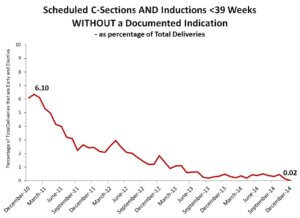Completed Initiatives
Past initiatives have focused on reducing preterm birth rates, improving breastfeeding rates, and enhancing perinatal care. OPQC’s collaborative approach has brought together healthcare providers, patients, and stakeholders to develop and implement evidence-based interventions, resulting in improved quality of care and positive health outcomes for mothers and babies across the state.
Completed Initiatives
AWHONN POST-BIRTH Warning Signs Initiative
Beginning in August 2018, OPQIC launched the AWHONN POST-BIRTH Warning Signs initiative. Using funds provided by the Oklahoma State Department of Health, OPQIC provided more that 1,300 nurses at 28 Oklahoma birthing hospitals free access to the AWHONN POST-BIRTH Warning Signs Online Education.
AIM Obstetric Hemorrhage Bundle (Every Mother Counts)
IMPACT: Between October 2015 and September 2021, the percentage of birthing patients at participating facilities who received a formal risk assessment for hemorrhage increased from 66% to 95%. During that same period, reported quantitative blood loss measurement for birthing patients at participating facilities increased from 30% to 80%.
AIM Severe Hypertension in Pregnancy Bundle (Every Mother Counts)
In 2015, the Oklahoma Perinatal Quality Improvement Collaborative (OPQIC) launched its Every Mother Counts collaborative and implemented AIM’s Severe Hypertension in Pregnancy patient safety bundle in 36 of the state’s 46 birthing facilities. As part of its collaborative, OPQIC facilitated in-person learning sessions and webinars, provided technical assistance for participating facilities and incentivized participation by providing stipends for quality improvement work.
IMPACT: Between October 2015 and December 2021, the percentage of birthing patients with persistent severe hypertension who received treatment within 60 minutes of an elevated reading increased from 57% to 79%, an increase of 28%. During that time, the percentage of participating facilities who reported having established unit policies and procedures to respond to hypertensive emergencies increased from 31% to 97%.
Eliminating Early Elective Deliveries (Every Week Counts)
The Every Week Counts (EWC) collaborative to reduce non-medically indicated scheduled deliveries prior to 39 weeks launched in 2011 and was completed in 2014. EWC was part of the Preparing for a Lifetime initiative and was supported by the Oklahoma State Department of Health, the March of Dimes, the Office of Perinatal Quality Improvement and the Oklahoma Hospital Association.

From Q1 2011 to Q4 2014, participating Oklahoma birthing hospitals, representing ~ 95% of Oklahoma births, demonstrated a 96% decrease in early elective deliveries! This equates to a decrease from 8 early elective deliveries every day to 1 early elective delivery every 3.5 days.
EWC Final Aggregate Report (Q4 2014)
A big THANK YOU for all of the hard work and time given by the participating hospitals. And, thanks also, to the partners who have supported this work.
Congratulations on a job well done!
While the Every Weeks Counts collaborative has concluded, hospitals are still required to submit their early elective delivery data to CMS. This is reported using the Joint Commission’s Perinatal Care Core Measure, Elective Delivery (PC-01). This data is reported publicly at https://www.medicare.gov/hospitalcompare.
Details on PC-01 can be found on the Joint Commission website at https://manual.jointcommission.org.